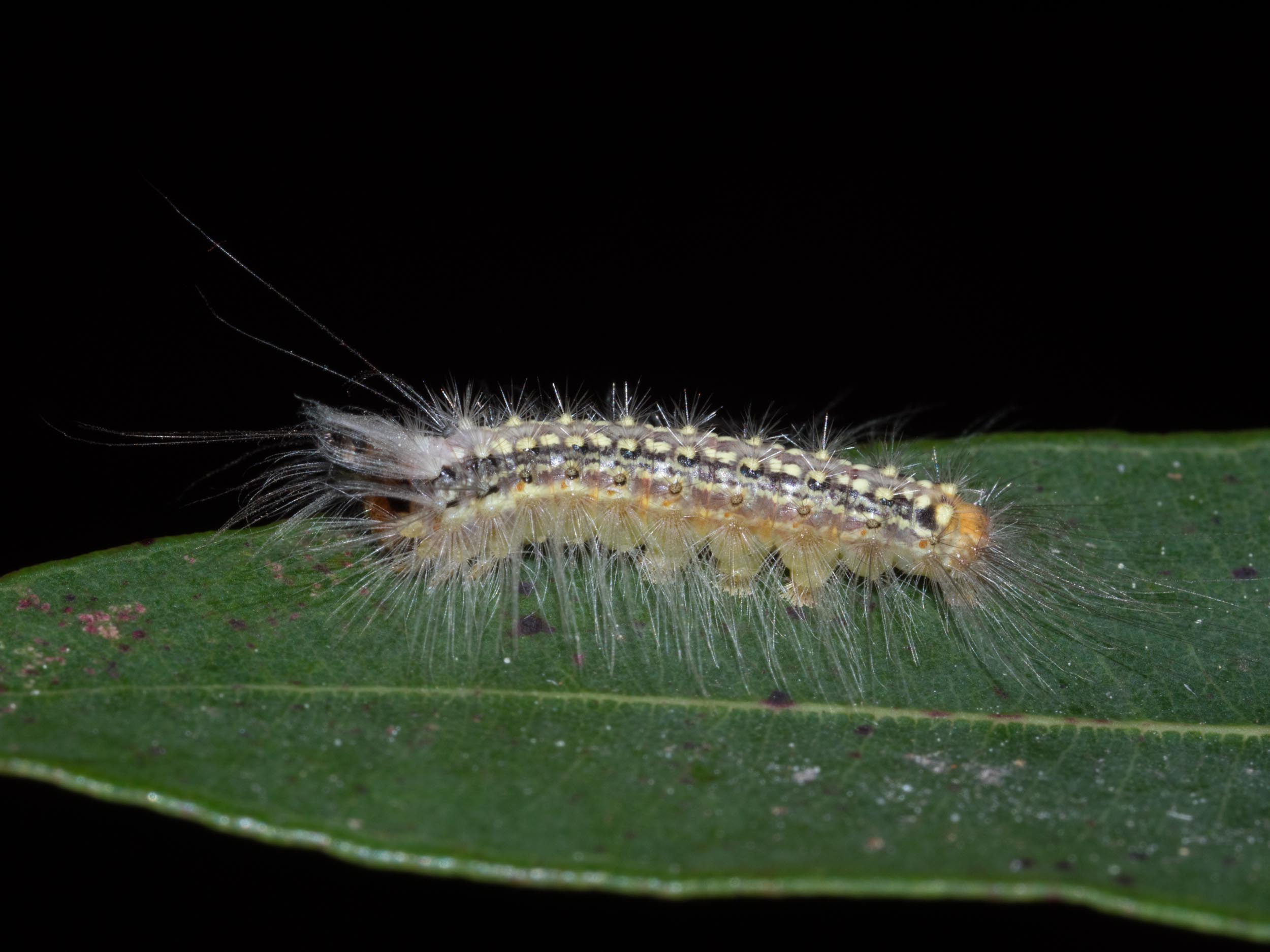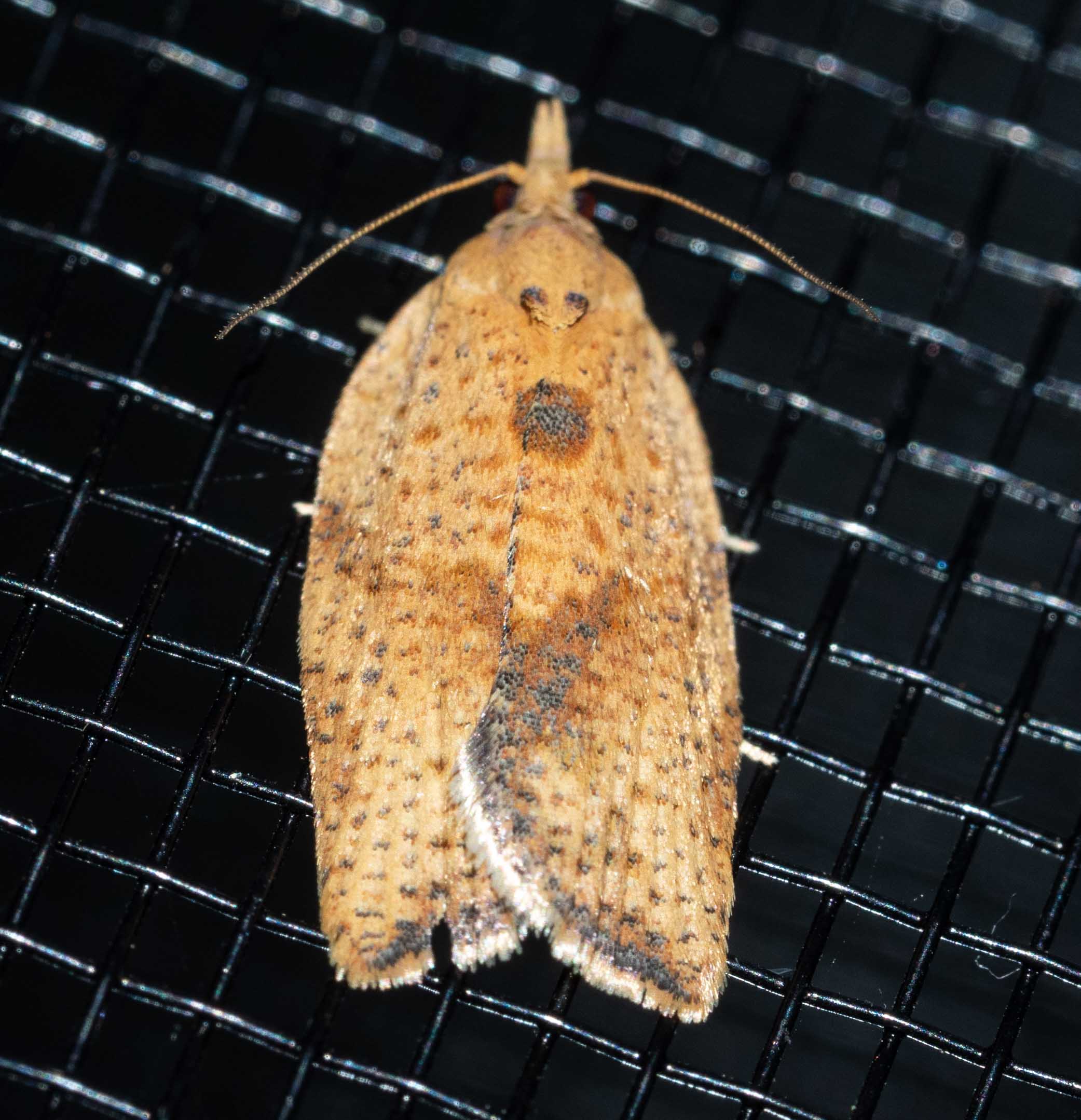Uraba lugens

Workbook
from Campbell, K.G. Proc. Linn. Soc. NSW 1962 v.87 316
Description of larva
Fully grown larva is 20-25mm in length, cream ventrally and pink with yellow and dark brown markings dorsally. It bears a characteristic “head dress” composed of successive moulted head capsules and prothoracic skins which are retained by the prothoracic setae instead of being shed with the remainder of the exuviae; up to six head capsules may be retained.
Each bod segment, except those bearing legs or prolegs, has two small tubercles ventrally, each tubercle being surmounted by a small rosette of grey setae. Laterally each segment bears two tubercle, the upper and larger being clothed with a rosette of barbed grey setae about twice as long as those borne by the lower.
Dorsally each segment bears four tubercles each surrounded by a small rosette of brown tipped setae, those setae present on the tubercles of the ninth abdominal segments, one of both types, some short and brown tipped and others long and barbed; some of the latter are grey, the others dark brown.
Prolegs are present on abdominal segments 4, 5, 6 and 10. Small tubercles bearing grey setae are borne just above the crochets, those setae on segments 4, 5 and 6 being clubbed.
Seasonal cycle
Two generations of Roeselia lugens can occur during the one year and these will be designated in this paper winter and summer generations respectively. Adults of the summer generation emerge from pupation during the period March, April and early May and copulation takes place soon after emergence.
Winter generation.
Oviposition, usually on fresh or undamaged foliage, commences about 10 days after emergence of the adults. Eggs are laid in more or less parallel rows which are spaced about one egg diameter apart; eggs are seldom laid on damaged leaves.
Eggs hatch in May or June and once the eggs of one mass begin to hatch the larvae from that mass all eclose within approximately one day. Young larvae exhibit overt gregariousness, and at first feed together in aggregations on the leaf surface on which the egg mass has been laid. During the 4th or 5th stadia the larvae begin to feed alone or two or three on a leaf.
After the fifth stadium the head capsules and prothoracic skins are not shed during ecdysis with the remainder of the exuviae, but remain attached above the prothorax by means of the setae. This process is continued at successive ecydses and when the larva is fully grown as many as five or six head capsules and prothoracic skins may be borne by the larvae. This head dress is characteristic of the larva of R. lugens.
The larvae pass through 11 stadia at this stage, which occupies the period between later May and early December in the Murray Valley Region. When about to pupate the larvae seek sheltered places in which to spin their cocoons, which are characterised by having the head dress woven into the outer silk. Pupation sites are on the small twigs of the crown, the upper trunk, but mainly beneath flakes of bark on the rough lower trunk or beneath litter on the forest floor. Moths of the winter generation emerge from pupation during December and early January.
Summer Generation
Eggs are laid during the period December to early February. The larvae begin to hatch during January and feed gregariously until the 4th or 5th stadium, after which they feed one or two to a leaf. The larval stage is completed by early March.
Pupation occurs during mid-March to early April. The moths emerge from pupation during the period March, April and early May.
Emergence of adults
Prior to emergence the pupa becomes active and makes an opening at the anterior end of the cocoon by means of a raised ridge-like process on the head. The pupal skin splits and the adult moth emerges. After an hour or so, during which the wings enlarge and dry, the moth flies upwards to the nearest foliage.
Egg Stage
Eggs are laid on either side of a leaf blade. Except rarely, only leaves undamaged by any destructive agency and which have developed fully in size, but are still young, are favoured oviposition sites. Despite this, eggs which are not laid on such leaves can develop normally and hatch.
The eggs are flattened, cylindrical and about 0.5mm in diameter by 0.25mm high. They are laid in parallel rows which are composed of eggs laid successively, the margin of one egg touching that of the next. The rows are usually about one egg diameter apart, but the symmetry may be disturbed for the reasons mentioned previously when describing the behaviour of adult females during oviposition.
The developmental period of the eggs is about 5 weeks during autumn and less in summer. Shartly after the head capsules is clearly visible within the egg, eclosion of the larva takes place.
The larva ecloses by pushing off the disc shaped operculum of the egg to emerge head first and the larvae of one egg mass all emerge within a day or so of one another. They young larvae are overtly gregarious and at first they feed together on the leaf surface close to the egg mass from which they have emerged. Only the palisade layer and spongy mesophyll of the leaf are eaten by young larvae: the oil cells and veins are avoided. This results in skeletonizing of the leaf and this hair is referred to in the common name of the insect.
19/3/12 laid on E. cypellocarpa
hatching of this clutch on 20/4/12
these larvae from 16/1/15 are different in appearance to the ones from 26/10/15 and 5/10/16 in having very long setae on dorsal side. They may be a different species or just an early instar of Uraba lugens which differs from later instars.
An adult photographed on bedroom window at night. Identified by Glenn Cocking.
This is a workbook page … a part of our website where we record the observations and references used in making species identifications. The notes will not necessarily be complete. They are a record for our own use, but we are happy to share this information with others.













